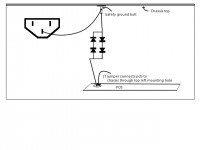I need some info reagarding the grounding in monoblock amplifiers. How do i evoid ground loop. Which are the rules for good grounding in monoblocks?
Regarding grounding your mono blocks see:
http://www.diyaudio.com/forums/power-supplies/115698-understanding-star-grounding-43.html
Cheers / Chris
Hi
I would like an answer to this as well as I am making a pair of monoblock gainclones. As each one will be in a seperate metal enclosure that will need connecting to mains earth for safety. Should I leave all the audio floating unconnected to ground in any way and rely on the interconnects from the preamp grounding them back at the preamp. Or should I put a ground lift 10 ohm resistor in each monoblock between signal ground and mains earth.
Thanks
I would like an answer to this as well as I am making a pair of monoblock gainclones. As each one will be in a seperate metal enclosure that will need connecting to mains earth for safety. Should I leave all the audio floating unconnected to ground in any way and rely on the interconnects from the preamp grounding them back at the preamp. Or should I put a ground lift 10 ohm resistor in each monoblock between signal ground and mains earth.
Thanks
Same problem here
I just finished building two Leach monoblocks using his ver 4.5 boards with the 82 ohm signal ground lift resistor and star grounding. Each chassis is earthed via the earth connection on the power plug. Each one on its own is dead quiet but soon as I connect them to a pre-amp, there is hum.
For experimentation I put a cheater plug (adapter that breaks the earth connection) and whichever amp is lifted does not hum. I am looking for another cheater plug to try lifting both amp but if anyone has insight that would be great. I do not like leaving the chassis un-earthed.
I just finished building two Leach monoblocks using his ver 4.5 boards with the 82 ohm signal ground lift resistor and star grounding. Each chassis is earthed via the earth connection on the power plug. Each one on its own is dead quiet but soon as I connect them to a pre-amp, there is hum.
For experimentation I put a cheater plug (adapter that breaks the earth connection) and whichever amp is lifted does not hum. I am looking for another cheater plug to try lifting both amp but if anyone has insight that would be great. I do not like leaving the chassis un-earthed.
Hi AndrewT, great question.
I did some more playing around. The monoblocks are driven by a Proceed AVP preamp. To my surprise, even if I had one audio input connected, it hummed. I have to isolate both monoblocks to get it quiet.
I tried the Proceed with a Krell KSA80, dual mono construction and it is dead silent.
Any thoughts?
I did some more playing around. The monoblocks are driven by a Proceed AVP preamp. To my surprise, even if I had one audio input connected, it hummed. I have to isolate both monoblocks to get it quiet.
I tried the Proceed with a Krell KSA80, dual mono construction and it is dead silent.
Any thoughts?
I just confirmed that R51 is 82r in his ver 4.5 board.
I gutted two Hafler DH200 for this project and I located the star ground by the power transformer and the bridge rectifier. I have two banks of capacitors, one of 2 x 18000uF and one of 8 x 3300uF. The center points of each cap bank go back to the star ground and so do the board ground connections. I will try to draw it up later.
I gutted two Hafler DH200 for this project and I located the star ground by the power transformer and the bridge rectifier. I have two banks of capacitors, one of 2 x 18000uF and one of 8 x 3300uF. The center points of each cap bank go back to the star ground and so do the board ground connections. I will try to draw it up later.
rather than using cheater plugs. used diodes. The connection is a virtual cheater plug until the forward voltage drop (usally .7 volts per diode) is exceeded, then it becomes a ground. observe current requirements and voltage ratings. you can use this any where you would use a cheater plug or lift resister.
Attachments
- Status
- This old topic is closed. If you want to reopen this topic, contact a moderator using the "Report Post" button.
- Home
- Amplifiers
- Tubes / Valves
- Grounding in monoblock amps
